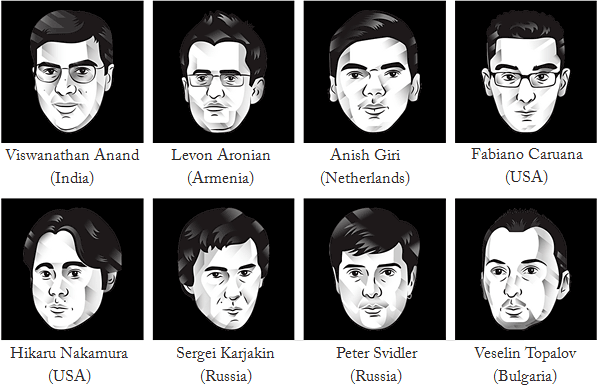


This 14-round event, which determines the next Challenger to Magnus Carlsen's title, will take place in Moscow from March 10–30. An official partner of the tournament, which is supported by the Russian Chess Federation, is the “Tashir Group”. Organizer is the AGON, the commercial partner of the World Chess Federation, which will also stage the World Championship 2016, from 11-30 November in New York.
The 2016 Candidates will see eight players, including six of the World’s top-ten rated grandmasters, representing six countries, taking part.
According to FIDE regulations the list of players includes the top two performers from the 2014-2015 Grand Prix: Hikaru Nakamura and Fabiano Caruana (both of the USA); the winner and runner-up of the 2015 World Cup, Sergey Karjakin and Peter Svidler (both of Russia); as well as the loser of the 2014 World Chess Championship match, Viswanathan Anand of India; Veselin Topalov of Bulgaria and Anish Giri of the Netherlands, based on their 2015 FIDE ratings are likely to have qualified to participate. The eighth and final participant is Levon Aronian of Armenia, who was chosen as Wild Card entry by the Organizers.

Here is a table of all eight Candidates, with their current (March 1st 2016) ratings and their current world rankings:
| Candidate |
Rating
|
Nation
|
Rank
|
| Fabiano Caruana |
2794
|
USA
|
3
|
| Anish Giri |
2793
|
NED
|
4
|
| Hikaru Nakamura |
2790
|
USA
|
6
|
| Levon Aronian |
2786
|
ARM
|
7
|
| Veselin Topalov |
2780
|
BUL
|
8
|
| Viswanathan Anand |
2762
|
IND
|
11
|
| Sergey Karjakin |
2760
|
RUS
|
13
|
| Peter Svidler |
2757
|
RUS
|
16
|
So who will win this event? We have a fascinating interview with Peter Heine Nielsen, who has been the second of both Anand and (currently) Carlsen:

Danish Grandmaster Peter Heine Nielsen is a well-known opening expert, who worked with Magnus Carlsen when the young Norwegian player used the Dragon as one of his weapons against 1.e4. He was second of World Champion Anand in his matches against Vladimir Kramnik, Veselin Topalov and Boris Gelfand. Recently, he started to work again with Magnus Carlsen. Peter Heine was in Hamburg recording more DVDs when the above interview was conducted.
The guaranteed prize fund of the Candidates Tournament will be in excess of 420,000 USD. First prize is €95,000, second €88,000, third €75,000, fourth €55,000, fifth €40,000, sixth €28,000, seventh €22,000 and eighth €17,000.
The time control for the games is 100 minutes for the first 40 moves, 50 minutes for the next 20 moves and then 15 minutes for the rest of the game, plus an additional 30 seconds per move starting from move
one.
Tiebreaks: If two or more players score the same points at the top of the list, the tie will be decided by the following criteria, in order of priority:
If there is no clear winner with the above three criteria, there will be a special competition between the players who still remain tied after using the 3rd criteria (Sonneborn Berger): after a new drawing of colors, each tied player will play two tiebreak games with the other tied opponent(s). The games shall be played using the electronic clock starting with 25 minutes for each player with an increment of 10 seconds after each move. If one or more players are still tied there will be a two-game blitz match (5m + 3s) between them, and if there is still a tie an Armageddon game (five minutes vs four minutes, White must win).
The Central Telegraph, an historic building on Tverskaya Street in the heart of Moscow, is the site of the 2016 Candidates tournament to select a challenger for the World Championship.

The building, which provides fixed line telephony and Internet access, was inaugurated in 1929

This is what it looks like today. The Central Telegraph has a large multifunctional space
within the building, will be the actual venue for the tournament [pictures from Wikimedia]
The Candidates Tournament will feature a new, modern design for the playing space and for the spectators. It will have state-of-the-art design and production features for the players, the spectators and for the streaming broadcast of the event over official site (WorldChess.com).

Area for visitors and press briefings area
The interior space where the players will compete and the spectators can watch has been designed by Novoe Architectural Bureau. It is a fully integrated area with distinct spaces for the competition, for news conferences, and for spectators who want to watch the games directly, listen to commentary or possibly play some games themselves.

The playing area with the four tables

There is a glass-enclosed VIP area, which is sponsored by Beluga ...

... that overlooks the playing area, much like a sky-box in regular sporting events.

For the live broadcasting of the games and the commentary there is a spacious television studio ...

... that overlooks the visitors’ area and playing hall.
Links
|